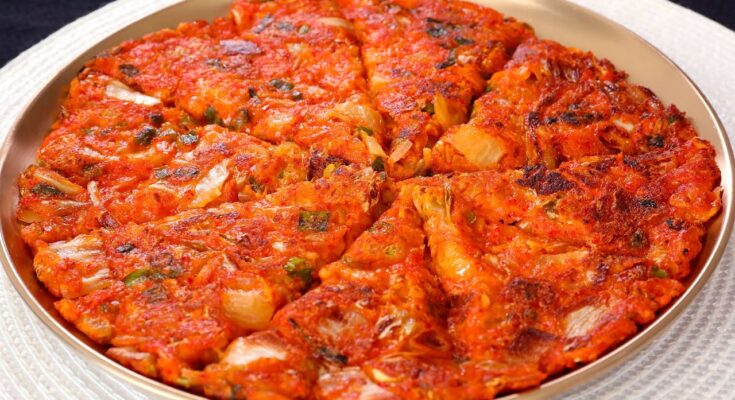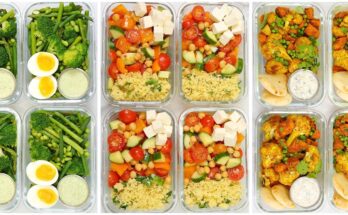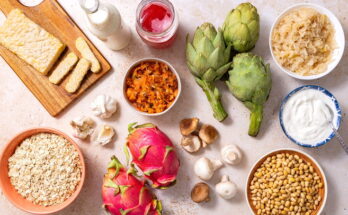Kimchi Pancake Recipe: Kimchi pancakes, also known as Kimchi Jeon or Kimchi Buchimgae, are one of Korea’s most beloved comfort foods. Imagine biting into a crispy, savory pancake with a punch of tangy, spicy kimchi flavor—it’s the perfect snack, appetizer, or even a full meal when paired with other Korean side dishes. Unlike the sweet pancakes we often think of in the West, kimchi pancakes are savory and loaded with umami-rich ingredients that make them incredibly satisfying.
So, what makes them so popular? Well, kimchi pancakes are fast, easy to make, and only require a handful of ingredients. The best part is that they’re budget-friendly and perfect for using up leftover kimchi that’s gotten extra sour. In fact, the more fermented your kimchi, the deeper and richer the flavor of your pancakes will be. This makes them a sustainable and delicious dish that never goes to waste.
Texture-wise, kimchi pancakes strike a beautiful balance. The edges turn golden brown and crispy, while the inside stays soft and chewy, giving you that delightful contrast with every bite. The flavors are bold, thanks to kimchi’s tangy, spicy kick, but they’re also comforting and hearty—exactly what you want on a cozy night in or when entertaining guests.
Whether you’re a seasoned cook or someone just beginning to explore Korean cuisine, this kimchi pancake recipe is straightforward, fun, and incredibly rewarding. Get ready to whip up a plate of crispy, flavorful pancakes that will wow your taste buds and maybe even become a new household favorite.
Ingredients You’ll Need
The beauty of kimchi pancakes is their simplicity. You don’t need a long list of fancy or expensive ingredients—just a few pantry staples and, of course, kimchi. Here’s a breakdown of what you’ll need:
Core Ingredients for Kimchi Pancakes
- Kimchi (1 cup, chopped): The star of the dish. Older, well-fermented kimchi works best because it has a stronger flavor.
- Kimchi juice (2–3 tablespoons): The liquid from the kimchi jar adds extra tang and color.
- All-purpose flour (1 cup): This forms the base of the batter.
- Water (½ cup): To mix with the flour and create the batter consistency.
- Egg (1 large): Helps bind the ingredients together and adds richness.
- Salt (a pinch): Enhances the flavor of the pancake.
- Cooking oil (for frying): Neutral oils like vegetable, canola, or sunflower oil work best.
Optional Add-Ins for Extra Flavor
- Green onions (2–3 stalks, chopped): Adds freshness and crunch.
- Onion slices (½ cup): Brings sweetness and depth.
- Seafood (shrimp, squid, or oysters): For a popular variation known as Haemul Kimchi Jeon.
- Chili peppers (sliced): For those who love extra heat.
- Sesame seeds: Adds nuttiness and aroma.
Choosing the Best Kimchi
When it comes to making the perfect kimchi pancake, the type of kimchi you use matters. Freshly made kimchi can work, but it doesn’t provide the same punch as aged kimchi. Over time, kimchi ferments and develops a deeper sourness and umami flavor that’s ideal for pancakes. If you’re buying store-bought kimchi, check the label to ensure it’s naturally fermented. If it’s homemade, even better!
Pro tip: If your kimchi is too watery, squeeze out some of the liquid before chopping, or your pancake batter may become too runny. But don’t throw away the juice—that’s liquid gold for flavor!
Essential Kitchen Tools
Making kimchi pancakes doesn’t require a fancy kitchen setup. A few reliable tools will do the trick, and you might already have most of them at home.
Cooking Pan vs. Skillet
The pan is the heart of this recipe. A non-stick skillet is ideal because it prevents sticking and makes flipping much easier. Cast-iron skillets are also a fantastic choice since they retain heat well and create beautifully crispy edges. Just make sure to use enough oil to prevent burning.
Mixing Bowls and Utensils
You’ll need at least one medium-sized mixing bowl for preparing the batter. A whisk or wooden spoon will work perfectly for mixing the ingredients. If you’re adding seafood or lots of vegetables, a larger bowl may be more convenient.
Other Helpful Kitchen Tools
- Sharp knife and cutting board: For chopping kimchi and vegetables.
- Measuring cups and spoons: To keep the ratios right.
- Spatula: A wide, flat spatula makes flipping the pancake easier.
- Paper towels: To drain excess oil after frying, keeping the pancakes crispy.
Having the right tools won’t just make cooking easier—it’ll also help you achieve that crispy, golden finish without frustration.
Step-by-Step Guide to Making Kimchi Pancakes
Now that you have your ingredients and tools ready, let’s dive into the cooking process. Making kimchi pancakes is simple, but a few small techniques can make all the difference between soggy and perfectly crispy.
Step 1 – Preparing the Batter
Start by making the base batter. In a mixing bowl, combine all-purpose flour (or a mix of flour and rice flour for extra crispiness) with a pinch of salt. Add cold water gradually and whisk until you get a smooth, slightly thick batter. The consistency should be pourable but not too runny—similar to pancake batter.
Step 2 – Mixing in Kimchi and Add-Ons
Chop your kimchi into small bite-sized pieces and add it to the batter, along with a spoonful of kimchi juice for extra flavor. You can also mix in sliced scallions, thinly chopped onions, or even seafood (like shrimp or squid) if you want a richer version. Stir everything together until well combined.
Step 3 – Heating the Pan
Place a non-stick skillet on medium-high heat and add a drizzle of vegetable oil (or sesame oil for extra fragrance). Make sure the oil is evenly spread, as this helps the pancake develop that signature crispy edge. Wait until the pan is hot before pouring in the batter.
Step 4 – Cooking the Pancakes
Pour a ladle of the kimchi batter into the pan and spread it out thinly into a round shape. Cook for about 3–4 minutes until the edges start turning golden and crispy. Don’t overcrowd the pan—cook one or two at a time, depending on size.
Step 5 – Flipping and Finishing
Using a wide spatula, carefully flip the pancake over and cook the other side for another 2–3 minutes until golden brown and cooked through. Once done, transfer to a plate and repeat with the remaining batter. Serve hot with a simple dipping sauce made of soy sauce, rice vinegar, sesame seeds, and a touch of chili flakes.
Serving Suggestions
Kimchi pancakes taste amazing on their own, but pairing them with the right sauce or side dishes can take the experience to the next level.
Classic Korean Dipping Sauce
The most common dipping sauce for kimchi pancakes is a simple mixture of soy sauce, rice vinegar, sesame oil, sesame seeds, and chopped green onions. Some people like to add chili flakes for extra spice or a bit of sugar for balance. This sauce enhances the tangy flavor of the kimchi and adds a savory-sour kick.
Pairing Kimchi Pancakes with Other Dishes
In Korean cuisine, pancakes are often served as part of a larger meal with banchan (small side dishes). They pair beautifully with steamed rice, Korean BBQ, or a hot bowl of soup like doenjang jjigae (soybean paste stew).
Garnishes for Extra Appeal
For presentation and extra flavor, sprinkle your pancakes with sesame seeds, sliced scallions, or even a drizzle of spicy gochujang sauce. These little touches make them look more appetizing and restaurant-worthy.
Tips for Perfect Kimchi Pancakes
Cooking kimchi pancakes might seem simple, but achieving that crispy on the outside, soft on the inside texture requires a bit of know-how. Here are some insider tips to make sure your pancakes turn out perfect every single time.
How to Get Crispy Edges
The key to crispy edges is oil and heat. Make sure your skillet is well-heated before adding the batter—medium-high heat works best. Don’t be afraid to use a generous amount of oil, enough to lightly coat the pan. Think of it as shallow-frying rather than just greasing the pan.
Another trick is to spread the batter thinly. A thinner pancake cooks faster and develops more crispiness along the edges. Avoid piling the batter too thick, as it can lead to soggy centers and burnt edges.
If you love extra crunch, try sprinkling a small amount of cornstarch into your flour mixture. It helps absorb moisture and creates a crispier bite.
Adjusting the Batter Consistency
Your batter consistency will make or break the pancake. Too watery, and the pancake falls apart; too thick, and it becomes heavy and doughy. The batter should be pourable but thick enough to hold kimchi and add-ins together.
A great tip is to test-fry a small spoonful first. If it holds together and crisps nicely, you’re good to go. If not, tweak with a splash of water or a spoonful of flour until it’s just right.
Common Mistakes to Avoid
- Using fresh kimchi only: Fresh kimchi lacks depth. Always go for aged kimchi for maximum flavor.
- Not chopping kimchi properly: Large chunks can make the pancake uneven. Chop into bite-sized pieces.
- Cooking on low heat: Low heat results in soggy pancakes. Keep the heat at medium-high for crispiness.
- Flipping too early: Let the pancake cook undisturbed for 3–4 minutes before flipping, or it will break apart.
- Skipping the dipping sauce: The sauce is not just optional—it elevates the flavor dramatically.
Variations of Kimchi Pancakes
Kimchi pancakes are wonderfully versatile. While the basic recipe is always a hit, you can experiment with different variations to suit your preferences or dietary needs.
Seafood Kimchi Pancake
One of the most popular versions is Haemul Kimchi Jeon (Seafood Kimchi Pancake). Simply add shrimp, squid, or oysters to your batter for an umami-packed twist. The seafood blends beautifully with the tangy kimchi and makes the pancake more hearty and filling.
For best results, chop the seafood into small pieces so it distributes evenly in the batter. Fresh or frozen both work fine—just make sure to pat them dry before mixing to avoid excess moisture.
Vegan Kimchi Pancake
If you’re vegan, you can still enjoy this delicious dish. Simply skip the egg and substitute it with a flaxseed or chia seed mixture (1 tablespoon seeds + 3 tablespoons water). Also, make sure your kimchi is vegan since traditional recipes sometimes use fish sauce or shrimp paste.
You can also add extra vegetables like mushrooms, zucchini, or carrots to boost flavor and texture.
Mini Bite-Sized Kimchi Pancakes
Instead of making one large pancake, try cooking smaller, snack-sized pancakes. These are perfect for parties, appetizers, or lunch boxes. They cook faster, are easier to flip, and look super appealing on a platter.
You can even serve them on toothpicks with dipping sauce for a fun finger-food experience.
Health Benefits of Kimchi Pancakes
Kimchi pancakes are indulgent but also come with surprising health perks, especially if you prepare them thoughtfully.
Nutritional Value of Kimchi
Kimchi is a fermented food rich in probiotics, which support gut health and digestion. It’s also packed with vitamins A, B, and C, plus antioxidants that help fight inflammation. The garlic, chili, and ginger in kimchi bring additional immune-boosting properties.
Healthy Cooking Alternatives
While frying gives the best crispiness, you can lighten up your pancakes with a few tweaks:
- Use whole wheat flour instead of all-purpose for extra fiber.
- Reduce oil by pan-frying with a non-stick spray.
- Add more vegetables like zucchini or spinach for extra nutrients.
Making Kimchi Pancakes Gluten-Free
If you’re avoiding gluten, swap the all-purpose flour with rice flour or a gluten-free flour blend. Rice flour, in particular, makes the pancakes even crispier while keeping them light.
This means that with a few modifications, kimchi pancakes can fit into almost any diet—whether you’re vegan, gluten-free, or simply trying to eat healthier.
Storage and Reheating Tips
Kimchi pancakes are best eaten fresh, straight from the pan. But if you’ve made extras or want to prepare ahead, here’s how to store and reheat them without losing too much of their crispiness.
How to Store Leftovers
Once cooled, stack pancakes with parchment paper in between (to prevent sticking) and store them in an airtight container. They’ll stay fresh in the refrigerator for up to 3 days.
Reheating Methods
- Pan-Frying (Best Method): Heat a non-stick pan with a little oil and reheat each side until crispy again.
- Oven: Place pancakes on a baking sheet at 350°F (175°C) for 10 minutes.
- Microwave (Not Recommended): It makes the pancakes soggy, but if you’re in a rush, it’s an option.
Freezing Kimchi Pancakes
For longer storage, freeze pancakes in a single layer on a baking sheet, then transfer to a freezer-safe bag. When ready to eat, thaw slightly and pan-fry to bring back the crispiness. They’ll last for up to 2 months in the freezer.
FAQs about Kimchi Pancake Recipe
1. Can I Use Store-Bought Kimchi?
Yes! Store-bought kimchi works perfectly. Just make sure it’s fermented and flavorful. Older kimchi is better for pancakes.
2. Can I Make Pancakes Without Flour?
Yes. You can use rice flour, chickpea flour, or even potato starch as a substitute. Rice flour makes the crispiest pancakes.
3. How Long Do Kimchi Pancakes Last?
They stay fresh for 2–3 days in the refrigerator. For longer storage, freeze them.
4. Can I Make Them Ahead of Time?
Yes, you can prepare the batter in advance and cook the pancakes just before serving. Alternatively, cook them and reheat using a pan or oven.
5. What Is the Best Oil for Frying?
Neutral oils like vegetable, canola, or sunflower oil are best. Avoid olive oil since it has a lower smoke point and can alter the flavor.
Conclusion
Kimchi pancakes are more than just a quick snack—they’re a delightful blend of crispy texture, bold flavors, and cultural tradition. With just a handful of ingredients, you can whip up a dish that’s both comforting and exciting. Whether you stick to the classic version or experiment with seafood, vegan, or mini variations, kimchi pancakes are sure to satisfy your cravings.
They’re easy enough for weeknight cooking yet impressive enough to serve at gatherings. Plus, with the health benefits of kimchi and the versatility of the recipe, you’ll never run out of reasons to make them. So next time you have leftover kimchi sitting in your fridge, turn it into a golden, crispy pancake and enjoy a taste of Korea in your kitchen.



